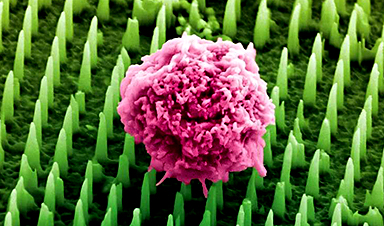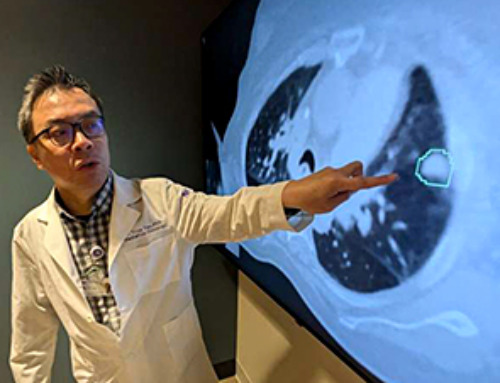One of the most common COVID-19 tests involves a long swab pressed deep into the nasal cavities – and while the test can be administered quickly, it has been described as unpleasant and uncomfortable.
Now researchers at The Ohio State University are working on a testing system that would require a simple exhaled breath. Perena Gouma is the primary investigator of a team developing a breathalyzer device that will sample breath for key biomarkers of the infection. She says it would serve as an alternative to current tests that are expensive, can take a long time to get results and require specialized personnel to do the sampling and to analyze the results.
Gouma, director of the Advanced Ceramics Research Laboratory and professor in the College of Engineering, is working with co-investigator Andrew Bowman, associate professor of veterinary preventive medicine. The project was awarded a nearly $200,000 National Science Foundation EAGER grant this month under a program supporting exploratory, early-stage research on untested, but potentially transformative, ideas or approaches.
“Breath analysis is not really a technique that is used widely in the medical field yet, so it is considered early-stage work,” Gouma said. “[We] have a sensor device that detects nitric oxide and VOCs (volatile organic compounds) in breath and can be used to tell you about the onset of an infectious disease.”
In addition to nitric oxide, the device examines two other metabolites that could specifically indicate the presence of a COVID-19 infection even in asymptomatic patients. Exhaling once in the breathalyzer may help with earlier detection of the onset of the disease, as well as with monitoring of the severity of the infection, which could help reduce the risk for worsening of the symptoms and allow timely therapeutic intervention, she said.
The new project builds upon Gouma’s invention of a hand-held breath monitor that may provide early detection of flu before symptoms appear prior to her arrival at Ohio State. The COVID-19 breathalyzer involves advances on nanomaterials for detecting specific breath gases at the concentrations of interest for making a diagnosis.
The breathalyzer gives results rapidly (15 seconds response time), it is extremely inexpensive, and it is easy to use so that there is no need for trained personnel to perform the test, Gouma said. The results can be viewed directly on the display or they can be transferred to the physician wirelessly.
“We are working on making these hand-held monitors that will be widely distributed and they’re very inexpensive,” she said. “The technology evolved from the sensors used for monitoring gases in an automotive exhaust – that’s how we started on breath analysis 20 years ago.”
Image Credit: NIAID/NIH/SPL
![]()
News This Week
Johns Hopkins Researchers Uncover a New Way To Kill Cancer Cells
A new study reveals that blocking ribosomal RNA production rewires cancer cell behavior and could help treat genetically unstable tumors. Researchers at the Johns Hopkins Kimmel Cancer Center and the Department of Radiation Oncology and Molecular [...]
AI matches doctors in mapping lung tumors for radiation therapy
In radiation therapy, precision can save lives. Oncologists must carefully map the size and location of a tumor before delivering high-dose radiation to destroy cancer cells while sparing healthy tissue. But this process, called [...]
Scientists Finally “See” Key Protein That Controls Inflammation
Researchers used advanced microscopy to uncover important protein structures. For the first time, two important protein structures in the human body are being visualized, thanks in part to cutting-edge technology at the University of [...]
AI tool detects 9 types of dementia from a single brain scan
Mayo Clinic researchers have developed a new artificial intelligence (AI) tool that helps clinicians identify brain activity patterns linked to nine types of dementia, including Alzheimer's disease, using a single, widely available scan—a transformative [...]
Is plastic packaging putting more than just food on your plate?
New research reveals that common food packaging and utensils can shed microscopic plastics into our food, prompting urgent calls for stricter testing and updated regulations to protect public health. Beyond microplastics: The analysis intentionally [...]
Aging Spreads Through the Bloodstream
Summary: New research reveals that aging isn’t just a local cellular process—it can spread throughout the body via the bloodstream. A redox-sensitive protein called ReHMGB1, secreted by senescent cells, was found to trigger aging features [...]
AI and nanomedicine find rare biomarkers for prostrate cancer and atherosclerosis
Imagine a stadium packed with 75,000 fans, all wearing green and white jerseys—except one person in a solid green shirt. Finding that person would be tough. That's how hard it is for scientists to [...]
Are Pesticides Breeding the Next Pandemic? Experts Warn of Fungal Superbugs
Fungicides used in agriculture have been linked to an increase in resistance to antifungal drugs in both humans and animals. Fungal infections are on the rise, and two UC Davis infectious disease experts, Dr. George Thompson [...]
Scientists Crack the 500-Million-Year-Old Code That Controls Your Immune System
A collaborative team from Penn Medicine and Penn Engineering has uncovered the mathematical principles behind a 500-million-year-old protein network that determines whether foreign materials are recognized as friend or foe. How does your body [...]
Team discovers how tiny parts of cells stay organized, new insights for blocking cancer growth
A team of international researchers led by scientists at City of Hope provides the most thorough account yet of an elusive target for cancer treatment. Published in Science Advances, the study suggests a complex signaling [...]
Nanomaterials in Ophthalmology: A Review
Eye diseases are becoming more common. In 2020, over 250 million people had mild vision problems, and 295 million experienced moderate to severe ocular conditions. In response, researchers are turning to nanotechnology and nanomaterials—tools that are transforming [...]
Natural Plant Extract Removes up to 90% of Microplastics From Water
Researchers found that natural polymers derived from okra and fenugreek are highly effective at removing microplastics from water. The same sticky substances that make okra slimy and give fenugreek its gel-like texture could help [...]
Instant coffee may damage your eyes, genetic study finds
A new genetic study shows that just one extra cup of instant coffee a day could significantly increase your risk of developing dry AMD, shedding fresh light on how our daily beverage choices may [...]
Nanoneedle patch offers painless alternative to traditional cancer biopsies
A patch containing tens of millions of microscopic nanoneedles could soon replace traditional biopsies, scientists have found. The patch offers a painless and less invasive alternative for millions of patients worldwide who undergo biopsies [...]
Small antibodies provide broad protection against SARS coronaviruses
Scientists have discovered a unique class of small antibodies that are strongly protective against a wide range of SARS coronaviruses, including SARS-CoV-1 and numerous early and recent SARS-CoV-2 variants. The unique antibodies target an [...]
Controlling This One Molecule Could Halt Alzheimer’s in Its Tracks
New research identifies the immune molecule STING as a driver of brain damage in Alzheimer’s. A new approach to Alzheimer’s disease has led to an exciting discovery that could help stop the devastating cognitive decline [...]






















